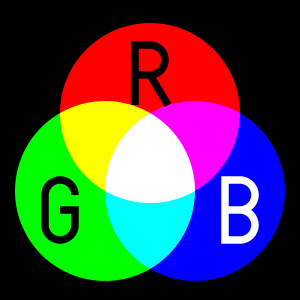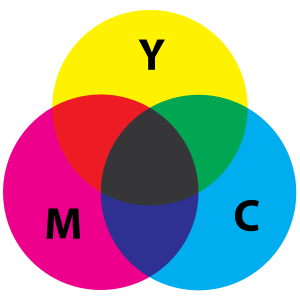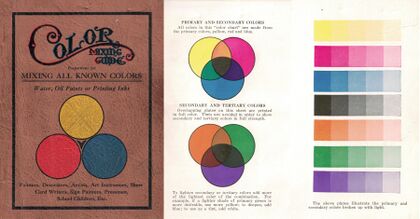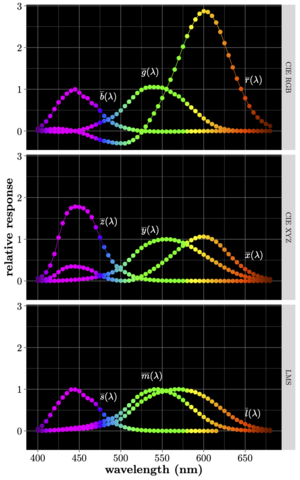لون أولي

A set of primary colors or primary colours (see spelling differences) consists of colorants or colored lights that can be mixed in varying amounts to produce a gamut of colors. This is the essential method used to create the perception of a broad range of colors in, e.g., electronic displays, color printing, and paintings. Perceptions associated with a given combination of primary colors can be predicted by an appropriate mixing model (e.g., additive, subtractive) that reflects the physics of how light interacts with physical media, and ultimately the retina. The most common color mixing models are the additive primary colors (red, green, blue) and the subtractive primary colors (cyan, magenta, yellow).
Primary colors can also be conceptual (not necessarily real), either as additive mathematical elements of a color space or as irreducible phenomenological categories in domains such as psychology and philosophy. Color space primaries are precisely defined and empirically rooted in psychophysical colorimetry experiments which are foundational for understanding color vision. Primaries of some color spaces are complete (that is, all visible colors are described in terms of their primaries weighted by nonnegative primary intensity coefficients) but necessarily imaginary[1] (that is, there is no plausible way that those primary colors could be represented physically, or perceived). Phenomenological accounts of primary colors, such as the psychological primaries, have been used as the conceptual basis for practical color applications even though they are not a quantitative description in and of themselves.
Sets of color space primaries are generally arbitrary, in the sense that there is no one set of primaries that can be considered the canonical set. Primary pigments or light sources are selected for a given application on the basis of subjective preferences as well as practical factors such as cost, stability, availability etc.
The concept of primary colors has a long, complex history. The choice of primary colors has changed over time in different domains that study color. Descriptions of primary colors come from areas including philosophy, art history, color order systems, and scientific work involving the physics of light and perception of color.
Art education materials commonly use red, yellow, and blue as primary colors, sometimes suggesting that they can mix all colors. No set of real colorants or lights can mix all possible colors, however. In physics, the three primary colors are typically red, green and blue, after the different types of photoreceptor pigments in the cone cells.[2][3]
أوليات نموذج الألوان
A color model is an abstract model intended to describe the ways that colors behave, especially in color mixing. Most color models are defined by the interaction of multiple primary colors. Since most humans are trichromatic, color models that want to reproduce a meaningful portion of a human's perceptual gamut must use at least three primaries.[4] More than three primaries are allowed, for example, to increase the size of the gamut of the color space, but the entire human perceptual gamut can be reproduced with just three primaries (albeit imaginary ones as in the CIE XYZ color space).
Some humans (and most mammals[5]) are dichromats, corresponding to specific forms of color blindness in which color vision is mediated by only two of the types of color receptors. Dichromats require only two primaries to reproduce their entire gamut and their participation in color matching experiments was essential in the determination of cone fundamentals leading to all modern color spaces.[6] Despite most vertebrates being tetrachromatic,[7] and therefore requiring four primaries to reproduce their entire gamut, there is only one scholarly report of a functional human tetrachromat, for which trichromatic color models are insufficient.[8]
النماذج الجمعية
The perception elicited by multiple light sources co-stimulating the same area of the retina is additive, i.e., predicted via summing the spectral power distributions (the intensity of each wavelength) of the individual light sources assuming a color matching context.[9] For example, a purple spotlight on a dark background could be matched with coincident blue and red spotlights that are both dimmer than the purple spotlight. If the intensity of the purple spotlight was doubled it could be matched by doubling the intensities of both the red and blue spotlights that matched the original purple. The principles of additive color mixing are embodied in Grassmann's laws.[10] Additive mixing is sometimes described as "additive color matching"[11] to emphasize the fact the predictions based on additivity only apply assuming the color matching context. Additivity relies on assumptions of the color matching context such as the match being in the foveal field of view, under appropriate luminance, etc.[12]
Additive mixing of coincident spot lights was applied in the experiments used to derive the CIE 1931 colorspace (see color space primaries section). The original monochromatic primaries of the wavelengths of 435.8 nm (violet), 546.1 nm (green), and 700 nm (red) were used in this application due to the convenience they afforded to the experimental work.[13]
Small red, green, and blue elements (with controllable brightness) in electronic displays mix additively from an appropriate viewing distance to synthesize compelling colored images. This specific type of additive mixing is described as partitive mixing.[9] Red, green, and blue light are popular primaries for partitive mixing since primary lights with those hues provide a large color triangle (gamut).[14]
The exact colors chosen for additive primaries are a compromise between the available technology (including considerations such as cost and power usage) and the need for large chromaticity gamut. For example, in 1953 the NTSC specified primaries that were representative of the phosphors available in that era for color CRTs. Over decades, market pressures for brighter colors resulted in CRTs using primaries that deviated significantly from the original standard.[15] Currently, ITU-R BT.709-5 primaries are typical for high-definition television.[16]
النماذج الطرحية
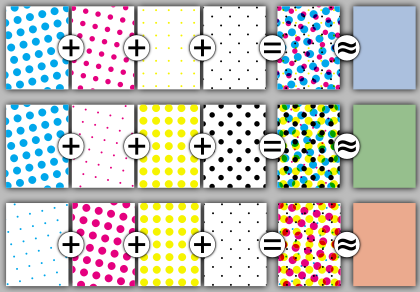
The subtractive color mixing model predicts the resultant spectral power distribution of light filtered through overlaid partially absorbing materials, usually in the context of an underlying reflective surface such as white paper.[9][17] Each layer partially absorbs some wavelengths of light from the illumination while letting others pass through, resulting in a colored appearance. The resultant spectral power distribution is predicted by the wavelength-by-wavelength product of the spectral reflectance of the illumination and the product of the spectral reflectances of all of the layers.[18] Overlapping layers of ink in printing mix subtractively over reflecting white paper, while the reflected light mixes in a partitive way to generate color images.[9][19] Importantly, unlike additive mixture, the color of the mixture is not well predicted by the colors of the individual dyes or inks. The typical number of inks in such a printing process is 3 (CMY) or 4 (CMYK), but can commonly range to 6 (e.g., Pantone hexachrome). In general, using fewer inks as primaries results in more economical printing but using more may result in better color reproduction.[20]
Cyan (C), magenta (M), and yellow (Y) are good chromatic subtractive primaries in that filters with those colors can be overlaid to yield a surprisingly large chromaticity gamut.[21] A black (K) ink (from the older "key plate") is also used in CMYK systems to augment C, M and Y inks or dyes due to both being more efficient in terms of time and expense and less likely to introduce visible defects.[22] Before the color names cyan and magenta were in common use, these primaries were often known as blue and red, respectively, and their exact color has changed over time with access to new pigments and technologies.[23] Organizations such as Fogra,[24] European Color Initiative and SWOP publish colorimetric CMYK standards for the printing industry.[25]
Traditional red, yellow, and blue primary colors as a subtractive system
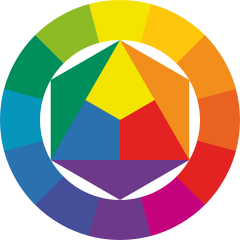
Color theorists since the seventeenth century, and many artists and designers since that time, have taken red, yellow, and blue to be the primary colors (see history below). This RYB system, in "traditional color theory", is often used to order and compare colors, and sometimes proposed as a system of mixing pigments to get a wide range of, or "all", colors.[27] O'Connor describes the role of RYB primaries in traditional color theory:[28]
A cornerstone component of traditional color theory, the RYB conceptual color model underpins the notion that the creation of an exhaustive gamut of color nuances occurs via intermixture of red, yellow, and blue pigments, especially when applied in conjunction with white and black pigment color. In the literature relating to traditional color theory and RYB color, red, yellow, and blue are often referred to as primary colors and represent exemplar hues rather than specific hues that are more pure, unique, or proprietary variants of these hues.
Traditional color theory is based on experience with pigments, more than on the science of light. In 1920, Snow and Froehlich explained:[29]
It does not matter to the makers of dyes if, as the physicist says, red light and green light in mixture make yellow light, when they find by experiment that red pigment and green pigment in mixture produce gray. No matter what the spectroscope may demonstrate regarding the combination of yellow rays of light and blue rays of light, the fact remains that yellow pigment mixed with the blue pigment produces green pigment.
The widespread adoption of teaching of RYB as primary colors in post-secondary art schools in the twentieth century has been attributed to the influence of the Bauhaus, where Johannes Itten developed his ideas on color during his time there in the 1920s, and of his book on color[30][31] published in 1961.[26]
In discussing color design for the web, Jason Beaird writes:[32]
The reason many digital artists still keep a red, yellow, and blue color wheel handy is because the color schemes and concepts of traditional color theory are based on that model. ... Even though I design mostly for the Web—a medium that's displayed in RGB—I still use red, yellow, and blue as the basis for my color selection. I believe that color combinations created using the red, yellow, and blue color wheel are more aesthetically pleasing, and that good design is about aesthetics.
Of course, the notion that all colors can be mixed from RYB primaries is not true, just as it is not true in any system of real primaries.[33] For example, if the blue pigment is a deep Prussian blue, then a muddy desaturated green may be the best that can be had by mixing with yellow.[34] To achieve a larger gamut of colors via mixing, the blue and red pigments used in illustrative materials such as the Color Mixing Guide in the image are often closer to peacock blue (a blue-green or cyan) and carmine (or crimson or magenta) respectively.[34][35][36] Printers traditionally used inks of such colors, known as "process blue" and "process red", before modern color science and the printing industry converged on the process colors (and names) cyan and magenta[34][36] (this is not to say that RYB is the same as CMY, or that it is exactly subtractive, but that there is a range of ways to conceptualize traditional RYB as a subtractive system in the framework of modern color science).
Faber-Castell identifies the following three colors: "Cadmium yellow" (number 107) for yellow, "Phthalo blue" (number 110) for blue and "Deep scarlet red" (number 219) for red, as the closest to primary colors for its Art & Graphic color pencils range. "Cadmium yellow" (number 107) for yellow, "Phthalo blue" (number 110) for blue and "Pale geranium lake" (number 121) for red, are provided as primary colors in its basic 5 color "Albrecht Dürer" watercolor marker set.
Mixing pigments in limited palettes

The first known use of red, yellow, and blue as "simple" or "primary" colors, by Chalcidius, ca. AD 300, was possibly based on the art of paint mixing.[38]
Mixing pigments for the purpose of creating realistic paintings with diverse color gamuts is known to have been practiced at least since Ancient Greece (see history section). The identity of a/the set of minimal pigments to mix diverse gamuts has long been the subject of speculation by theorists whose claims have changed over time, for example, Pliny's white, black, one or another red, and "sil", which might have been yellow or blue; Robert Boyle's white, black, red, yellow, and blue; and variations with more or fewer "primary" color or pigments. Some writers and artists have found these schemes difficult to reconcile with the actual practice of painting.[39] Nonetheless, it has long been known that limited palettes consisting of a small set of pigments are sufficient to mix a diverse gamut of colors.[40][41][42][43][44]
The set of pigments available to mix diverse gamuts of color (in various media such as oil, watercolor, acrylic, gouache, and pastel) is large and has changed throughout history.[45][46] There is no consensus on a specific set of pigments that are considered primary colors – the choice of pigments depends entirely on the artist's subjective preference of subject and style of art, as well as material considerations like lightfastness and mixing behavior.[47] A variety of limited palettes have been employed by artists for their work.[48][49]
The color of light (i.e., the spectral power distribution) reflected from illuminated surfaces coated in paint mixes is not well approximated by a subtractive or additive mixing model.[50] Color predictions that incorporate light scattering effects of pigment particles and paint layer thickness require approaches based on the Kubelka–Munk equations,[51] but even such approaches are not expected to predict the color of paint mixtures precisely due to inherent limitations.[52] Artists typically rely on mixing experience and "recipes"[53][54] to mix desired colors from a small initial set of primaries and do not use mathematical modeling.
MacEvoy explains why artists often chose a palette closer to RYB than to CMY:[55]
Because the 'optimal' pigments in practice produce unsatisfactory mixtures; because the alternative selections are less granulating, more transparent, and mix darker values; and because visual preferences have demanded relatively saturated yellow to red mixtures, obtained at the expense of relatively dull green and purple mixtures. Artists jettisoned 'theory' to obtain the best color mixtures in practice.
Color space primaries
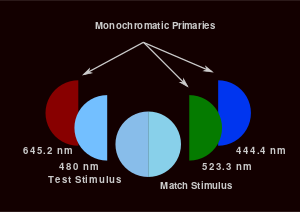
A color space is a subset of a color model, where the primaries have been defined, either directly as photometric spectra, or indirectly as a function of other color spaces. For example, sRGB and Adobe RGB are both color spaces based on the RGB color model. However, the green primary of Adobe RGB is more saturated than the equivalent in sRGB, and therefore yields a larger gamut.[63] Otherwise, choice of color space is largely arbitrary and depends on the utility to a specific application.[1]
Imaginary primaries
Color space primaries are derived from canonical colorimetric experiments that represent a standardized model of an observer (i.e., a set of color matching functions) adopted by Commission Internationale de l'Eclairage (CIE) standards. The abbreviated account of color space primaries in this section is based on descriptions in Colorimetry - Understanding The CIE System.[64]
The CIE 1931 standard observer is derived from experiments in which participants observing a foveal 2° bipartite field with a dark surround. Half of the field is illuminated with a monochromatic test stimulus (ranging from 380 nm to 780 nm) and the other half is the matching stimulus illuminated with three coincident monochromatic primary lights: 700 nm for red (R), 546.1 nm for green (G), and 435.8 nm for blue (B).[64] These primaries correspond to CIE RGB color space. The intensities of the primary lights could be adjusted by the participant observer until the matching stimulus matched the test stimulus, as predicted by Grassman's laws of additive mixing. Different standard observers from other color matching experiments have been derived since 1931. The variations in experiments include choices of primary lights, field of view, number of participants etc.[65] but the presentation below is representative of those results.
Matching was performed across many participants in incremental steps along the range of test stimulus wavelengths (380 nm to 780 nm) to ultimately yield the color matching functions: , and that represent the relative intensities of red, green, and blue light to match each wavelength (). These functions imply that units of the test stimulus with any spectral power distribution, , can be matched by [R], [G], and [B] units of each primary where:[64]
-
(Eq. 1)
Each integral term in the above equation is known as a tristimulus value and measures amounts in the adopted units. No set of real primary lights can match another monochromatic light under additive mixing so at least one of the color matching functions is negative for each wavelength. A negative tristimulus value corresponds to that primary being added to the test stimulus instead of the matching stimulus to achieve a match.
The negative tristimulus values made certain types of calculations difficult, so the CIE put forth new color matching functions , , and defined by the following linear transformation:[64]
-
(Eq. 2)
These new color matching functions correspond to imaginary primary lights X, Y, and Z (CIE XYZ color space). All colors can be matched by finding the amounts [X], [Y], and [Z] analogously to [R], [G], and [B] as defined in Eq. 1. The functions , , and based on the specifications that they should be nonnegative for all wavelengths, be equal to photometric luminance, and that for an equienergy (i.e., a uniform spectral power distribution) test stimulus.[64]
Derivations use the color matching functions, along with data from other experiments, to ultimately yield the cone fundamentals: , and . These functions correspond to the response curves for the three types of color photoreceptors found in the human retina: long-wavelength (L), medium-wavelength (M), and short-wavelength (S) cones. The three cone fundamentals are related to the original color matching functions by the following linear transformation (specific to a 10° field):[64]
-
(Eq. 3)
LMS color space comprises three primary lights (L, M, and S) that stimulate only the L-, M-, and S-cones respectively. A real primary that stimulates only the M-cone is impossible, and therefore these primaries are imaginary. The LMS color space has significant physiological relevance as these three photoreceptors mediate trichromatic color vision in humans.
Both XYZ and LMS color spaces are complete since all colors in the gamut of the standard observer are contained within their color spaces. Complete color spaces must have imaginary primaries, but color spaces with imaginary primaries are not necessarily complete (e.g. ProPhoto RGB color space).
Real primaries
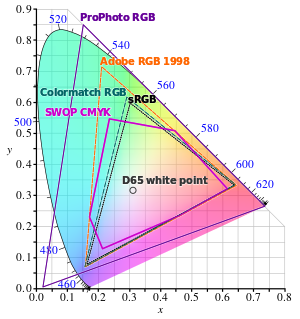
Color spaces used in color reproduction must use real primaries that can be reproduced by practical sources, either lights in additive models, or pigments in subtractive models. Most RGB color spaces have real primaries, though some maintain imaginary primaries. For example, all the sRGB primaries fall within the gamut of human perception, and so can be easily represented by practical light sources, including CRT and LED displays, hence why sRGB is still the color space of choice for digital displays.
A color in a color space is defined as a combination of its primaries, where each primary must give a non-negative contribution. Any color space based on a finite number of real primaries is incomplete in that it cannot reproduce every color within the gamut of the standard observer.
Practical color spaces such as sRGB[66] and scRGB[67] are typically (at least partially) defined in terms of linear transformations from CIE XYZ, and color management often uses CIE XYZ as a middle point for transformations between two other color spaces.
Most color spaces in the color-matching context (those defined by their relationship to CIE XYZ) inherit its three-dimensionality. However, more complex color appearance models like CIECAM02 require extra dimensions to describe colors appear under different viewing conditions.[68]
Psychological primaries
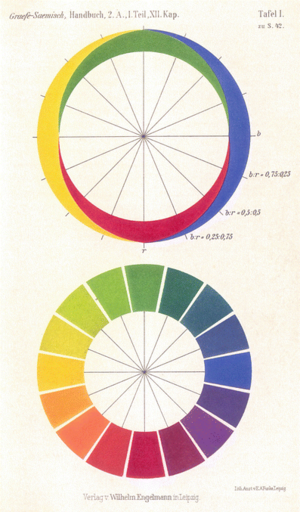
The opponent process was proposed by Ewald Hering in which he described the four unique hues (later called psychological primaries in some contexts): red, green, yellow and blue.[70] To Hering, the unique hues appeared as pure colors, while all others were "psychological mixes" of two of them. Furthermore, these colors were organized in "opponent" pairs, red vs. green and yellow vs. blue so that mixing could occur across pairs (e.g., a yellowish green or a yellowish red) but not within a pair (i.e., reddish green cannot be imagined). An achromatic opponent process along black and white is also part of Hering's explanation of color perception. Hering asserted that we did not know why these color relationships were true but knew that they were.[71] Although there is a great deal of evidence for the opponent process in the form of neural mechanisms,[72] there is currently no clear mapping of the psychological primaries to neural correlates.[73]
The psychological primaries were applied by Richard S. Hunter as the primaries for Hunter L,a,b colorspace that led to the creation of CIELAB.[74] The Natural Color System is also directly inspired by the psychological primaries.[75]
History
Philosophy
Philosophical writing from ancient Greece has described notions of primary colors but they can be difficult to interpret in terms of modern color science. Theophrastus (c. 371–287 BCE) described Democritus' position that the primary colors were white, black, red, and green.[76] In Classical Greece, Empedocles identified white, black, red, and, (depending on the interpretation) either yellow or green as primary colors.[76] Aristotle described a notion in which white and black could be mixed in different ratios to yield chromatic colors;[76] this idea had considerable influence in Western thinking about color. François d'Aguilon's notion of the five primary colors (white, yellow, red, blue, black) was influenced by Aristotle's idea of the chromatic colors being made of black and white.[76]The 20th century philosopher Ludwig Wittgenstein explored color-related ideas using red, green, blue, and yellow as primary colors.[77][78]
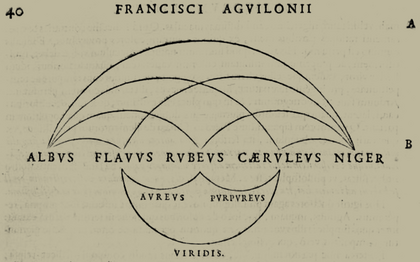
Light and color vision
Isaac Newton used the term "primary color" to describe the colored spectral components of sunlight.[80][81] A number of color theorists did not agree with Newton's work. David Brewster advocated that red, yellow, and blue light could be combined into any spectral hue late into the 1840s.[82][83] Thomas Young proposed red, green, and violet as the three primary colors, while James Clerk Maxwell favored changing violet to blue.[84] Hermann von Helmholtz proposed "a slightly purplish red, a vegetation-green, slightly yellowish, and an ultramarine-blue" as a trio.[85] Newton, Young, Maxwell, and Helmholtz were all prominent contributors to "modern color science"[86] that ultimately described the perception of color in terms of the three types of retinal photoreceptors.
Colorants
John Gage's The Fortunes Of Apelles provides a summary of the history of primary colors[39] as pigments in painting and describes the evolution of the idea as complex. Gage begins by describing Pliny the Elder's account of notable Greek painters who used four primaries.[87] Pliny distinguished the pigments (i.e., substances) from their apparent colors: white from Milos (ex albis), red from Sinope (ex rubris), Attic yellow (sil) and atramentum (ex nigris). Sil was historically confused as a blue pigment between the 16th and 17th centuries leading to claims about white, black, red, and blue being the fewest colors required for painting. Thomas Bardwell, an 18th century Norwich portrait painter, was skeptical of practical relevance of Pliny's account.[88]
Robert Boyle, the Irish chemist, introduced the term primary color in English in 1664 and claimed that there were five primary colors (white, black, red, yellow, and blue).[40][89] The German painter Joachim von Sandrart eventually proposed removing white and black from the primaries and that one only needed red, yellow, blue, and green to paint "the whole creation".[39]
| Year | Author | Color terms | Descriptive term |
|---|---|---|---|
| c. 325 | Chalcidius | Pallidus, rubeus, cyaneus | Generic colors |
| c. 1266 | Roger Bacon | Glaucus, rubeus, viriditas | Principal species |
| c. 1609 | Anselmus de Boodt | Flavus, ruber, caeruleus | Principal colors |
| c. 1613 | François d'Aguilon | Flavus, rubeus, caeruleus | Simple colors |
| c. 1664 | Robert Boyle | Yellow, red, blue | Simple, primary |
| c. 1680 | André Félibien | Jaune, rouge, bleu | Principal, primitive |
Red, yellow, and blue as primaries became a popular notion in the 18th and 19th centuries. Jacob Christoph Le Blon, an engraver, was the first to use separate plates for each color in mezzotint printmaking: yellow, red, and blue, plus black to add shades and contrast. Le Blon used primitive in 1725 to describe red, yellow, and blue in a very similar sense as Boyle used primary.[86] Moses Harris, an entomologist and engraver, also describes red, yellow, and blue as "primitive" colors in 1766.[90] Léonor Mérimée described red, yellow, and blue in his book on painting (originally published in French in 1830) as the three simple/primitive colors that can make a "great variety" of tones and colors found in nature.[91] George Field, a chemist, used the word primary to describe red, yellow, and blue in 1835.[92] Michel Eugène Chevreul, also a chemist, discussed red, yellow, and blue as "primary" colors in 1839.[93][94]
Color order systems
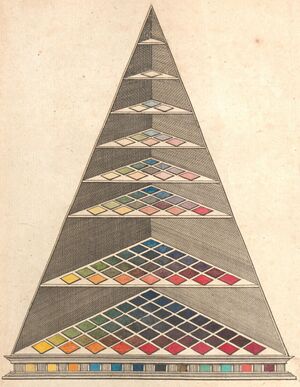
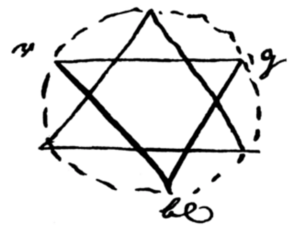
Historical perspectives[96] on color order systems[97] ("catalogs" of color) that were proposed in the 18th and 19th centuries describe them as using red, yellow, and blue pigments as chromatic primaries. Tobias Mayer (a German mathematician, physicist, and astronomer) described a triangular bipyramid with red, yellow and blue at the 3 vertices in the same plane, white at the top vertex, and black and the bottom vertex in a public lecture in 1758.[76] There are 11 planes of colors between the white and black vertices inside the triangular bipyramid. Mayer did not seem to distinguish between colored light and colorant though he used vermilion, orpiment (King’s yellow), and Bergblau (azurite) in partially complete colorings of planes in his solid.[98] Johann Heinrich Lambert (a Swiss mathematician, physicist, and astronomer) proposed a triangular pyramid with gamboge, carmine, and Prussian blue as primaries and only white at the top vertex (since Lambert could produce a mixture that was sufficiently black with those pigments).[76] Lambert's work on this system was published in 1772.[95] Philipp Otto Runge (the Romantic German painter) firmly believed in the theory of red, yellow and blue as the primary colors[98] (again without distinguishing light color and colorant). His color sphere was ultimately described in an essay titled Farben-Kugel[98] (color ball) published by Goethe in 1810.[98] His spherical model of colors equally spaced red, yellow, and blue longitudinally with orange, green, and violet between them, and white and black at opposite poles.[98]
Red, yellow, and blue as primary colors
Numerous authors have taught that red, yellow, and blue (RYB) are the primary colors in art education materials since at least the 19th century, following the ideas tabulated above from earlier centuries.[99][100][101]
A wide variety of contemporary educational sources also describe the RYB primaries. These sources range from children's books[102] and art material manufacturers[103] to painting[104] and color guides.[105] Art education materials often suggest that RYB primaries can be mixed to create all other colors.[106][107]
Criticism
Albert Munsell, an American painter (and creator of the Munsell color system), referred to the notion of RYB primaries as "mischief", "a widely accepted error", and underspecified in his book A Color Notation, first published in 1905.[108]
Itten's ideas about RYB primaries have been criticized as ignoring modern color science[76] with demonstrations that some of Itten's claims about mixing RYB primaries are impossible.[109]
See also
References
- ^ أ ب Bruce MacEvoy. "Do 'Primary' Colors Exist?" (imaginary or imperfect primaries section Archived 17 يوليو 2008 at the Wayback Machine). Handprint. Accessed 10 August 2007.
- ^ Primary Colors Are Red, Yellow and Blue, Right? Well, Not Exactly, HowStuffWorks
- ^ Introduction to the Primary Colors, Olympus Life Science
- ^ Westland, Stephen; Cheung, Vien (2012). Chen, Janglin; Cranton, Wayne; Fihn, Mark (eds.). Handbook of visual display technology (2nd ed.). Cham, Switzerland: Springer. p. 155. ISBN 978-3-540-79567-4.
Color vision is based upon the responses of three classes of cones in the retina, each of which has broadband sensitivity but maximum sensitivity at different wavelengths. A consequence of this is that color reproduction is trichromatic – the use of three primaries allows a wide range of colors to be reproduced.
- ^ Bowmaker, James K (May 1998). "Evolution of colour vision in vertebrates". Eye. 12 (3): 543. doi:10.1038/eye.1998.143. PMID 9775215.
- ^ Stockman, Andrew (2016). "Cone Fundamentals". Encyclopedia of Color Science and Technology. pp. 541–546. doi:10.1007/978-1-4419-8071-7_85. ISBN 978-1-4419-8070-0.
- ^ Scholtyßek, C.; Kelber, A. (November 2017). "Farbensehen der Tiere: Von farbenblinden Seehunden und tetrachromatischen Vögeln". Der Ophthalmologe. 114 (11): 978–985. doi:10.1007/s00347-017-0543-6. PMID 28752388.
- ^ Jordan, G.; Deeb, S. S.; Bosten, J. M.; Mollon, J. D. (20 July 2010). "The dimensionality of color vision in carriers of anomalous trichromacy". Journal of Vision. 10 (8): 12. doi:10.1167/10.8.12. PMID 20884587.
- ^ أ ب ت ث Williamson, Samuel J. (1983). Light and color in nature and art. New York: Wiley. ISBN 0471083747. Retrieved 28 April 2021.
- ^ Reinhard, Erik; Khan, Arif; Akyuz, Ahmet; Johnson, Garrett (2008). Color imaging : fundamentals and applications. Wellesley, Mass: A.K. Peters. pp. 364–365. ISBN 978-1-56881-344-8. Retrieved 31 December 2017.
- ^ Berns, Roy S. (2019). Billmeyer and Saltzman's principles of color technology (Fourth ed.). Hoboken, NJ. pp. 54–64. ISBN 9781119367192.
{{cite book}}: CS1 maint: location missing publisher (link) - ^ Brill, Michael H.; Robertson, Alan R. (27 July 2007). "Open Problems on the Validity of Grassmann's Laws". Colorimetry: 245–259. doi:10.1002/9780470175637.ch10. ISBN 9780470175637.
Grassmann's laws are known not to be exactly true in human color matching. Symmetry could be called into question by color difference formulas, such as CIE94,3 that are asymmetric between batch and standard. Transitivity can be considered to be violated if we take the term color match to mean that two colors are within a just-noticeable difference of each other. In this case, adding two subthreshold differences together could produce a combined difference that is above thresh- old. Proportionality and additivity can also be compromised. Besides the three cone types that herald the trichromacy of vision at high (photopic) light intensities, a fourth photoreceptor type (rods) contributes to vision at low (mesopic and scotopic) light intensities and away from the center of vision (fovea). At very high light intenities, unbleached photopigments deplete and, in aggregate, change their action spectrum. At still higher light intensities, a photopigment molecule can absorb multiple photons but respond as if it absorbed only one photon. All these effects compromise Grassmann's laws, but the successful application of the laws, for example, in photography and television, has led us to believe that the compromises are not serious.
- ^ Fairman, Hugh S.; Brill, Michael H.; Hemmendinger, Henry (February 1997). "How the CIE 1931 color-matching functions were derived from Wright-Guild data". Color Research & Application. 22 (1): 11–23. doi:10.1002/(SICI)1520-6378(199702)22:1<11::AID-COL4>3.0.CO;2-7.
The first of the resolutions offered to the 1931 meeting defined the color-matching functions of the soon-to-be-adopted standard observer in terms of Guild's spectral primaries centered on wavelengths 435.8, 546.1, and 700nm. Guild approached the problem from the viewpoint of a standardization engineer. In his mind, the adopted primaries had to be producible with national-standardizing-laboratory accuracy. The first two wavelengths were mercury excitation lines, and the last named wavelength occurred at a location in the human vision system where the hue of spectral lights was unchanging with wavelength. Slight inaccuracy in production of the wavelength of this spectral primary in a visual colorimeter, it was reasoned, would introduce no error at all.
- ^ Tooms, Michael S. (26 January 2016). Colour Reproduction in Electronic Imaging Systems: Photography, Television, Cinematography (in الإنجليزية). John Wiley & Sons. p. 22. ISBN 978-1-119-02176-6. Retrieved 25 February 2021.
If we now define the primaries in terms of the three colours which together in various ratios produce the largest gamut of colours in the eye–brain complex, then, as reasoned above, the primary colours are red, green and blue.
- ^ Poynton, Charles. "Frequently Asked Questions about Color" (PDF). Charles Poynton, PhD. Archived (PDF) from the original on 2018-02-19. Retrieved 26 April 2021.
The NTSC in 1953 specified a set of primaries that were representative of phosphors used in color CRTs of that era. But phosphors changed over the years, primarily in response to market pressures for brighter receivers, and by the time of the first the videotape recorder the primaries in use were quite different from those "on the books". So although you may see the NTSC primary chromaticities documented, they are of no use today.
- ^ Westland, Stephen; Cheung, Vien (2016). Chen, Janglin; Cranton, Wayne; Fihn, Mark (eds.). Handbook of visual display technology (2nd ed.). Cham, Switzerland: Springer. pp. 171–177. ISBN 978-3-319-14347-7.
- ^ Berns, Roy S. (9 April 2019). Billmeyer and Saltzman's Principles of Color Technology (in الإنجليزية). John Wiley & Sons. pp. 195–209. ISBN 978-1-119-36722-2.
- ^ Levoy, Marc. "Additive versus subtractive color mixing". graphics.stanford.edu. Retrieved 4 November 2020.
On the other hand, if you reflect light from a colored surface, or if you place a colored filter in front of a light, then some of the wavelengths present in the light may be partially or fully absorbed by the colored surface or filter. If we characterize the light as an SPD, and we characterize absorption by the surface or filter using a spectrum of reflectivity or transmissivity, respectively, i.e. the percentage of light reflected or transmitted at each wavelength, then the SPD of the outgoing light can be computed by multiplying the two spectra. This multiplication is (misleadingly) called subtractive mixing.
- ^ Kuehni, Rolf (2011). "Color mixture". Scholarpedia. 6 (1): 10686. Bibcode:2011SchpJ...610686K. doi:10.4249/scholarpedia.10686.
- ^ Sharma, Abhay (2018). Understanding color management (2nd ed.). Hoboken, NJ. p. 235. ISBN 9781119223634.
{{cite book}}: CS1 maint: location missing publisher (link) - ^ Westland, Stephen; Cheung, Vien (2012). Chen, Janglin; Cranton, Wayne; Fihn, Mark (eds.). Handbook of visual display technology (2nd ed.). Cham, Switzerland: Springer. p. 155. ISBN 978-3-540-79567-4.
The optimum primaries of the subtractive color system are cyan, magenta, and yellow. The use of cyan, magenta, and yellow subtractive primaries allows a surprisingly large – albeit limited – gamut of colors to be reproduced.
- ^ Poynton, Charles. "Color FAQ - Frequently Asked Questions Color". poynton.ca. Retrieved 27 April 2021.
Printing black by overlaying cyan, yellow and magenta ink in offset printing has three major problems. First, coloured ink is expensive. Replacing coloured ink by black ink – which is primarily carbon – makes economic sense. Second, printing three ink layers causes the printed paper to become quite wet. If three inks can be replaced by one, the ink will dry more quickly, the press can be run faster, and the job will be less expensive. Third, if black is printed by combining three inks, and mechanical tolerances cause the three inks to be printed slightly out of register, then black edges will suffer coloured tinges. Vision is most demanding of spatial detail in black and white areas. Printing black with a single ink minimizes the visibility of registration errors.
- ^ Ervin Sidney Ferry (1921). General Physics and Its Application to Industry and Everyday Life. John Wiley & Sons.
- ^ "FOGRA characterization data". International Color Consortium. Retrieved 26 April 2021.
- ^ Homann, Jan-Peter (2009). Digital color management : principles and strategies for the standardized print production. Berlin: Springer. ISBN 9783540693772.
- ^ أ ب Itten, Johannes (1961). The art of color : the subjective experience and objective rationale of color. New York: Reinhold Pub. Corp. pp. 34–37. ISBN 0442240376.
By way of introduction to color design, let us develop the 12-hue color circle from the primaries – yellow, red, and blue. As we know, a person with normal vision can identify a red that is neither bluish, nor yellowish; a yellow that is neither greenish, nor reddish: and a blue that is neither greenish, nor reddish. In examining each color, it is important to view it against a neutral-gray background.
- ^ O'Connor, Zena. "Traditional colour theory: A review." Color Research & Application, 8 January 2021.
- ^ Zena O’Connor (2021). "RYB Color". Encyclopedia of Color Science and Technology – Living Edition. Springer. pp. 1–4. doi:10.1007/978-3-642-27851-8_453-1. ISBN 978-3-642-27851-8. S2CID 241083080. Retrieved 6 June 2021.
- ^ Bonnie E. Snow and Hugo B. Froehlich (1920). The Theory and Practice of Color. Prang. p. 14. Retrieved 12 June 2021.
- ^ Gage, John (1982). "Colour at the Bahaus". AA Files (2): 50–54. ISSN 0261-6823. JSTOR 29543325.
- ^ Raleigh, Henry P. (1968). "Johannes Itten and the Background of Modern Art Education". Art Journal. 27 (3): 284–302. doi:10.2307/775089. JSTOR 775089.
- ^ Beaird, Jason (2010). The Principles of Beautiful Web Design. SitePoint. p. 55. ISBN 9781457192449. Retrieved 12 June 2021.[dead link]
- ^
Westland, Stephen (2016). Handbook of Visual Display Technology (PDF) (in الإنجليزية). Springer International Publishing. p. 162. doi:10.1007/978-3-319-14346-0_11. ISBN 9783319143460. Retrieved 12 December 2017.
A common misapprehension is that it is possible to define three color primaries that could create any color by mixture. Unfortunately, the range of reproducible colors (or gamut) for a trichromatic additive (or subtractive) system is limited and is always smaller than the gamut of all the colors possible in the world. However, the gamut is smaller or larger depending upon the choice of primaries. Pragmatically, for additive color mixing the largest gamut is achieved when the primaries are red, green, and blue.
- ^ أ ب ت
St. John, Eugene (February 1924). "Some Practical Hints on Presswork". The Inland Printer. 72 (5): 805.
While Prussian blue and crimson lake are available in three-color work, a broken yellow like Dutch pink is not, unless green and purple values may be sacrificed to obtain black. So a fourth printing in weak black or gray was added, and the three-color became the four-color process. At the same time, peacock blue was substituted to a large extent for Prussian blue. ... While process yellow may be considered lemon yellow, process red, carmine lake, three-color process blue, Prussian blue, and four-color process blue, peacock blue, many variations are encountered in practice; ... Bright reds may be mixed from process red and vermilion, chrome greens from process blue and process yellow, and useful purples from process red and reflex blue.
- ^
Raymer, Percy C. (1921). Photo-engravers' Hand-book on Etching & Finishing. Effingham Republican. p. 52. Retrieved 6 June 2021.
The so-called pure 'primary red pigment' (more correctly 'magenta') printed onto white paper absorbs the green light (its complementary) and the pure 'blue primary pigment', which is practically a strong cyan or peacock blue, absorbs the bright orange-red light (its complementary).
- ^ أ ب
United States Bureau of Naval Personnel (1967). Illustrator Draftsman 1 & C. U.S. GPO. p. 82. Retrieved 6 June 2021.
This is based on the fact that most colors can be approximated from a mixture of the primary colors – red, yellow, and blue. However, in process colors, the red is closer to a magenta than a vermilion, the blue is rather pale and greenish, and only the yellow is the bright, clear shade we usually think of as a primary color.
- ^ Harrison, Birge (1909). Landscape Painting (in الإنجليزية). Scribbner. p. 118.
The expert cannot be bothered with useless pigments. He selects the few that are really essential and throws aside the rest as useless lumber. The distinguished Swedish artist, Zorn, uses but two colors—vermilion and yellow ochre; his two other pigments black and white, being the negation of color. With this palette, simple to the point of poverty, he nevertheless finds it possible to paint an immense variety of landscape and figure subjects.
- ^ Kuehni, Rolf G. "Development of the idea of simple colors in the 16th and early 17th centuries". Color Research & Application 32.2 (2007): 92–99.
- ^ أ ب ت Gage, John (1999). Color and Culture: Practice and Meaning from Antiquity to Abstraction (in الإنجليزية). University of California Press. ISBN 978-0-520-22225-0.
- ^ أ ب Boyle, Robert (1664). Experiments and Considerations touching Colours. Henry Herringman. p. 220.
But I think I may easily be excus'd (though I do not altogether pass it by) if I restrain my self to the making of a Transient mention of some few of their Practices about this matter; and that only so far forth, as may warrant me to observe to you, that there are but few Simple and Primary Colours (if I may so call them) from whose Various Compositions all the rest do as it were Result. For though Painters can imitate the Hues (though not always the Splendor) of those almost Numberless differing Colours that are to be met with in the Works of Nature, and of Art, I have not yet found, that to exhibit this strange Variety they need imploy any more than White, and Black, and Red, and Blew, and Yellow; these five, Variously Compounded, and (if I may so speak) Decompounded, being sufficient to exhibit a Variety and Number of Colours, such, as those that are altogether Strangers to the Painters Pallets, can hardly imagine.
- ^ Rood, Ogden (1973). Modern chromatics; students' text-book of color, with applications to art and industry (PDF). New York: Van Nostrand Reinhold Co. p. 108. ISBN 0-442-27028-3. Archived (PDF) from the original on 2017-01-18.
It is well known to painters that approximate representations of all colours can be produced by the use of very few pigments. Three pigments or coloured powders will suffice, a red, yellow, and a blue; for example, crimson lake, gamboge, and Prussian blue. The red and yellow mingled in various proportions will furnish different shades of orange and orange-yellow; the blue and yellow will give a great variety of greens; the red and blue all the purple and violet hues. There have been instances of painters in water-colours who used only these three pigments, adding lampblack for the purpose of darkening them and obtaining the browns and greys.
- ^ Nyholm, Arvid (1914). "Anders Zorn: The Artist and the Man". Fine Arts Journal. 31 (4): 469–481. doi:10.2307/25587278. JSTOR 25587278.
It is true that Zorn uses only a very limited palette, especially when he paints indoors, when he considers that black, white, red and yellow should be enough for all ordinary purposes, except when a very decided color is present, as, for instance, a light blue or a positive green in a drapery.
- ^ Munsell, Albert H. (1907). A Color Notation.
Studio and school-room practice still cling to the discredited theory, claiming that, if it fails to describe our color sensations, yet it may be called practically true of pigments, because a red, yellow, and blue pigment suffice to imitate most natural colors.
- ^ Lintott, E. Barnard (1926). The Art of Water Colour Painting (in الإنجليزية). C. Scribner's Sons. p. 25.
For a young student there cannot be a better way of entering upon the study of water colour than by rigorously banishing all but two colours from his palette. It is the best and surest way to the study of full colour. The colours should be a cold and warm one; cobalt blue and warm sienna—or Prussian blue and burnt sienna—are two combinations which lend themselves to a great variety of treatment.
- ^ Eastaugh, Nicholas; Walsh, Valentine; Chaplin, Tracey; Siddall, Ruth (30 March 2007). Pigment Compendium: A Dictionary of Historical Pigments (in الإنجليزية). Routledge. ISBN 978-1-136-37386-2.
- ^ Ball, Philip (2002) [2001]. Bright earth : art and the invention of color (1st American ed.). New York: Farrar, Straus and Giroux. ISBN 0226036286.
- ^ MacEvoy, Bruce. "handprint : learning color through paints". www.handprint.com. Retrieved 27 April 2021.
- ^ MacEvoy, Bruce. "palette paintings". www.handprint.com. Retrieved 3 February 2021.
- ^ Gurney, James (2010). Color and Light: A Guide for the Realist Painter (in الإنجليزية). Kansas City, Missouri: Andrews McMeel Publishing. p. 104. ISBN 978-0-7407-9771-2.
- ^ Haase, Chet S.; Meyer, Gary W. (1 October 1992). "Modeling pigmented materials for realistic image synthesis". ACM Transactions on Graphics. 11 (4): 305–335. doi:10.1145/146443.146452. S2CID 6890110.
Section 2 develops some of the significant differences in additive and subtractive color mixing and discusses the need for different mixing theory for pigmented materials.
- ^ Lu, Jingwan; DiVerdi, Stephen; Chen, Willa A.; Barnes, Connelly; Finkelstein, Adam (8 August 2014). "RealPigment: paint compositing by example". Proceedings of the Workshop on Non-Photorealistic Animation and Rendering: 21–30. doi:10.1145/2630397.2630401. S2CID 1415118.
- ^ Curtis, Cassidy J.; Anderson, Sean E.; Seims, Joshua E.; Fleischer, Kurt W.; Salesin, David H. (1997). "Computer-generated watercolor". Proceedings of the 24th annual conference on Computer graphics and interactive techniques - SIGGRAPH '97. pp. 421–430. doi:10.1145/258734.258896. ISBN 0897918967. S2CID 3051452.
In summary, the fact that the KM model appears to work so well could actually be considered quite surprising, given the number of basic assumptions of the model violated by watercolor. We suspect that while the results of the model are probably not very physically accurate, they at least provide very plausible physical approximations, which appear quite adequate for many applications.
- ^ Powell, William F. (August 2012). 1,500 Color Mixing Recipes for Oil, Acrylic & Watercolor: Achieve Precise Color when Painting Landscapes, Portraits, Still Lifes, and More (in الإنجليزية). Walter Foster Publishing. ISBN 978-1-60058-283-7.
- ^ MacEvoy, Bruce. "handprint : basic mixing method". www.handprint.com.
- ^ MacEvoy, Bruce. "imaginary or imperfect primaries". handprint.com. Retrieved 13 June 2021.
- ^ "What is Meant by the Term "Observer Angle"?". X-Rite (in الإنجليزية). Retrieved 12 May 2021.
- ^ Stiles, W.S.; Burch, J. M. (December 1955). "Interim Report to the Commission Internationale de l'Eclairage, Zurich, 1955, on the National Physical Laboratory's Investigation of Colour-matching (1955)". Optica Acta: International Journal of Optics. 2 (4): 168–181. Bibcode:1955AcOpt...2..168S. doi:10.1080/713821039.
- ^ Stiles, W.S.; Burch, J. M. (December 1955). "Interim Report to the Commission Internationale de l'Eclairage, Zurich, 1955, on the National Physical Laboratory's Investigation of Colour-matching (1955)". Optica Acta: International Journal of Optics. 2 (4): 168–181. Bibcode:1955AcOpt...2..168S. doi:10.1080/713821039.
- ^ "Colour matching functions - Stiles & Burch (1955) 2-deg, RGB CMFs". cvrl.ioo.ucl.ac.uk.
- ^ "Colour matching functions - 2-deg XYZ CMFs transformed from the CIE (2006) 2-deg LMS cone fundamentals". cvrl.ioo.ucl.ac.uk.
- ^ Fundamental chromaticity diagram with physiological axes. Part 1. Vienna, Austria: Commission internationale de l'eclairage. 2006. ISBN 9783901906466.
- ^ "CVRL functions - 2-deg fundamentals based on the Stiles and Burch 10-deg CMFs adjusted to 2-deg". www.cvrl.org.
- ^ "sRGB vs. Adobe RGB 1998". Cambridge in Colour.
- ^ أ ب ت ث ج ح Schanda, János, ed. (2007). Colorimetry : understanding the CIE system. [Vienna, Austria]: CIE/Commission internationale de l'eclairage. ISBN 978-0-470-04904-4.
- ^ Li, Jiaye; Hanselaer, Peter; Smet, Kevin A. G. (17 February 2021). "Impact of Color-Matching Primaries on Observer Matching: Part I – Accuracy". LEUKOS. 18 (2): 104–126. doi:10.1080/15502724.2020.1864395.
- ^ Michael Stokes; Matthew Anderson; Srinivasan Chandrasekar; Ricardo Motta (5 November 1996). "A Standard Default Color Space for the Internet – sRGB, Version 1.10".
- ^ HP; Microsoft; IEC (23 January 2003). IEC (ed.). "Multimedia systems and equipment - Colour measurement and management - Part 2-2: Colour management - Extended RGB colour space - scRGB". IEC. Retrieved 18 April 2021.
- ^ Fairchild, Mark D. (2013). Color Appearance Models (3rd ed.). Hoboken: Wiley. p. 287. ISBN 9781119967033.
- ^ Hering, Ewald (1920). Grundzüge der Lehre vom Lichtsinn (in الألمانية). Springer Berlin Heidelberg. ISBN 978-3-662-42174-1.
- ^ Hering, Ewald (1964). Outlines of a theory of the light sense (in English). Harvard Univ. Press.
{{cite book}}: CS1 maint: unrecognized language (link) - ^ Turner, R. Steven (1994). In the eye's mind : vision and the Helmholtz-Hering controversy (in الإنجليزية). Princeton, New Jersey: Princeton University Press. pp. 130–133. ISBN 9781400863815.
- ^ Conway, Bevil R. (12 May 2009). "Color Vision, Cones, and Color-Coding in the Cortex". The Neuroscientist. 15 (3): 274–290. doi:10.1177/1073858408331369. PMID 19436076. S2CID 9873100.
- ^ MacLeod, Donald (21 May 2010). Cohen, Jonathan; Matthen, Mohan (eds.). Color Ontology and Color Science (in الإنجليزية). MIT Press. pp. 159–162. ISBN 978-0-262-01385-7.
Many color scientists, acknowledging that the color opponent signals observed in the pathway to cortex have no relation to the psychological primaries, do nevertheless take it for granted that a color opponent neural representation capable of accounting for the phenomenally simple or unitary quality of the psychological primaries must exist somewhere in the brain—in a region that is directly reflected in phenomenal experience, instead of merely conveying signals from the eye. This tenet was long maintained in the absence of neurophysiological evidence, and continues to be maintained even though current neurophysiological evidence does not support it.
- ^ "Application Note AN 1005.00 Measuring color using Hunter L, a, b versus CIE 1976 L*a*b*" (PDF). HunterLab. Hunter Associates Laboratory Inc. Archived (PDF) from the original on 2021-08-29. Retrieved 10 March 2021.
Hunter L, a, b and CIE 1976 L*a*b* (CIELAB) are both color scales based on the Opponent-Color Theory.
- ^ Maffi, Luisa (1997). Hardin, C.L. (ed.). Color categories in thought and language (1. publ. ed.). Cambridge: Cambridge University Press. pp. 163–192. ISBN 978-0-521-49800-5.
- ^ أ ب ت ث ج ح خ د Shamey, Renzo; Kuehni, Rolf G. (2020). Pioneers of Color Science. doi:10.1007/978-3-319-30811-1. ISBN 978-3-319-30809-8. S2CID 241801540.
- ^ Beran, Ondrej (2014). "The Essence (?) of Color, According to Wittgenstein". From the ALWS Archives: A Selection of Papers from the International Wittgenstein Symposia in Kirchberg Am Wechsel. Archived from the original on 2017-12-11. Retrieved 2017-12-11.
- ^ Wittgenstein, Ludwig (2005). The Big Typescript, TS. 213 (German-English scholar's ed.). Malden, MA: Blackwell Pub. ISBN 978-1405106993.
- ^ MacEvoy, Bruce. "do "primary" colors exist?". handprint : colormaking attributes. Retrieved 1 December 2020.
From a modern perspective, the most peculiar feature of d'Aguilon's theory is that these three "noble" hues were themselves created from the mysterious blending of white and black, or light and dark (upper curved lines in the figure), so that light and dark were the two "simple" or primary colors. The "composite" hues green, orange (gold), and purple (lower curved lines) were mixed from the "noble" triad colors. D'Aguilon's diagram was reprinted by the Jesuit scholar Athanasius Kircher in his optical treatise Ars magna lucis et umbrae (The Great Art of Light and Shadow, 1646). Both sources were widely read in the 17th century, and shaped the explanation of color mixing dominant during the Baroque.
- ^ Newton, Isaac (1730). Opticks: Or, A Treatise of the Reflections, Refractions, Inflections and Colours of Light (in الإنجليزية). William Innys at the West-End of St. Paul's. p. 135.
Whiteness and all grey Colours between white and black, may be compounded of Colours, and the whiteness of the Sun's Light is compounded of all the primary Colours mix'd in a due Proportion
- ^ Newton, Isaac (19 February 1671). "A Letter of Mr. Isaac Newton … containing his New Theory about Light and Color". Philosophical Transactions of the Royal Society (80): 3075–3087. Retrieved 19 November 2020.
The Original or primary colours are, Red, Yellow, Green, Blew, and a Violet-purple, together with Orange, Indico, and an indefinite variety of Intermediate gradations.
- ^ Boker, Steven M. "The Representation of Color Metrics and Mappings in Perceptual Color Space". The Representation of Color Metrics and Mappings in Perceptual Color Space.
- ^ MacEvoy, Bruce. "handprint : colormaking attributes". www.handprint.com.
The Scottish physicist David Brewster (1781-1868) was an especially pugnacious holdout, arguing as late as the 1840's that all spectral hues could be explained by red, yellow, and blue fundamental colors of light, which Brewster equated with three colored filters or transmittance curves that could reproduce the entire spectrum...
- ^ Maxwell, James Clerk (2013). The Scientific Papers of James Clerk Maxwell (in الإنجليزية). Courier Corporation. p. 49. ISBN 978-0-486-78322-2.
The experiments with pigments do not indicate what colours are to be considered as primary ; but experiments on the prismatic spectrum shew that all the colours of the spectrum, and therefore all the colours in nature, are equivalent to mixtures of three colours of the spectrum itself, namely, red, green (near the line E), and blue (near the line G). Yellow was found to be a mixture of red and green.
- ^ Alfred Daniell (1904). A text book of the principles of physics. Macmillan and Co. p. 575.
- ^ أ ب Mollon, J.D. (2003). The science of color (2nd ed.). Amsterdam: Elsevier. pp. 1–39. CiteSeerX 10.1.1.583.1688. ISBN 0-444-51251-9.
- ^ "32". Pliny the Elder, The Natural History, Book XXXV. An Account of Paintings and Colours.
It was with four colours only, that Apelles, Echion, Melanthius, and Nicomachus, those most illustrous painters, executed their immortal works; melinum for the white, Attic sil for the yellow, Pontic sinopis for the red, and atramentum for the black; and yet a single picture of theirs has sold before now for the treasures of whole cities. But at the present day, when purple is employed for colouring walls even, and when India sends to us the slime of her rivers, and the corrupt blood of her dragons and her elephants, there is no such thing as a picture of high quality produced. Everything, in fact, was superior at a time when the resources of art were so much fewer than they now are. Yes, so it is; and the reason is, as we have already stated, that it is the material, and not the efforts of genius, that is now the object of research.
- ^ Bardwell, Thomas; Richardson, Samuel; Millar, Andrew; Dodsley, Robert; Dodsley, James; Rivington, John; Rivington, James; Vivarès, François (1756). The practice of painting and perspective made easy : in which is contained, the art of painting in oil, with the method of colouring ... and a new, short, and familiar account of the art of perspective, illustrated with copper-plates, engraved by Mr. Vivares. London : Printed by S. Richardson, for the author, and sold by him ... and by A. Millar ... R. and J. Dodsley ..., and J. and J. Rivington ...
How it really was, Time has put it out of our Power to determine : But if we ſuppoſe thoſe four principal Colours in Perfection, then, I think, it can be no longer doubted, but that from them might be made all the various Colours in Nature. For my part, I cannot believe, that the four capital Colours of the Antients would mix to that ſurpriſing Perfection we ſee in the Works of Titian and Rubens. And if we have no certain Knowlege of their Method of Colouring who lived In the laſt Century, how ſhould we underſtand theirs who lived near Two thouſand Years ago ?
- ^ Briggs, David. "The Dimensions of Colour, primary colours". www.huevaluechroma.com.
- ^ Harris, Moses (1766). The natural system of colours : wherein is displayed the regular and beautiful order and arrangement, arising from the three premitives, red, blue, and yellow, the manner in which each colour is formed, and its composition, the dependance [sic] they have on each other, and by their harmonious connections are produced the teints, or colours, of every object in the creation, and those teints, tho' so numerous as 660, are all comprised in thirty three terms, only. Laidler's office, Princes-Street, Licester-Fields.
- ^ Mérimée, Jean-François-Léonor; Taylor, William Benjamin Sarsfield (1839). The Art of Painting in Oil and in Fresco, Being a History of the Various Processes and Materials Employed, from Its Discovery (in الإنجليزية). Whittaker & co. p. 245.
Although painters usually have arranged on their palettes a good many pigments of various deno- minations, yet they do not always seem to know, that three simple colours (yellow, red, and blue) can, by proper combination, be made to produce that great variety of tones and colours that we find in nature. United in pairs, these three primitive colours give birth to three other colours, as distinct and as brilliant as their originals; as thus, the yellow, mixed with red, gives the orange ; the red and blue, violet ; and the green is obtained by mixing blue and yellow, and, according to the preponderance of one or other colour in the mixture, will the tint incline towards that colour ; and as these proportions are graduated, we pass progressively from one colour to another, and from whatever point we begin, we return to it.
- ^ Field, George (1835). Chromatography; Or, A Treatise on Colours and Pigments: And of Their Powers in Painting (in الإنجليزية). Tilt and Bogue.
The Primary Colours are such as yield others by being compounded, but are not themselves capable of being produced by composition by other colours. They are three only, yellow, red, and blue...
- ^ Chevreul, Michel Eugène (1861). The Laws of Contrast of Colour. London: Routledge, Warne, and Routledge. p. 25. – English translation by John Spanton
- ^ MacEvoy, Bruce. "handprint : colormaking attributes". www.handprint.com.
- ^ أ ب ت Lambert, J.H. (1772). Beschreibung einer mit Calauischem Wachse ausgeführten Farbenpyramide. Berlin: Haude und Spener.
- ^ MacEvoy, Bruce. "handprint : colormaking attributes". www.handprint.com.
- ^ Kuehni, Rolf G. (2003). Color space and its divisions : color order from antiquity to the present. Hoboken, N.J.: Wiley-Interscience. ISBN 978-0-471-43226-5.
- ^ أ ب ت ث ج Kuehni, Rolf G. "Philipp Otto Runge's Color Sphere A translation, with related materials and an essay" (PDF). Archived (PDF) from the original on 2019-01-20. Retrieved 2 February 2021.
- ^ Osborn, Laughton (1856). Handbook of Young Artists and Amateurs in Oil Painting: Being Chiefly a Condensed Compilation from the Celebrated Manual of Bouvier ... Appended, A New Explanatory and Critical Vocabulary (in الإنجليزية). J. Wiley & son.
- ^ Calkins, Norman Allison (1888). Primary Object Lessons: For Training the Senses and Developing the Faculties of Children ... (in الإنجليزية). Harper & Bros. p. 195.
- ^ King, John L. (1923). Color mixing guide for artists, painters, decorators, printing pressmen, show card writers, sign painters, color mixers, give color mixtures by parts (in English). Fine Arts Publishing.
{{cite book}}: CS1 maint: unrecognized language (link) - ^ Vance, Cynthia (2008). Red, yellow, blue, and you (1st ed.). New York: Abbeville Kids. ISBN 9780789209696.
- ^ "Crayola Support FAQ-What are the primary colors?". www.crayola.com.
What are the primary colors? Primary colors include red, blue, and yellow. Primary colors cannot be mixed from other colors. They are the source of all other colors.
- ^ Pitcher, Colette (16 March 2011). Watercolor Painting For Dummies (in الإنجليزية). John Wiley & Sons. ISBN 978-1-118-05200-6.
- ^ Stephen Quiller (2002). Color Choices. Watson–Guptill. ISBN 0-8230-0697-2.
- ^ "Color". www.nga.gov. Retrieved 10 December 2017.
Red, blue, and yellow are the primary colors. With paints of just these three colors, artists can mix them to create all the other colors.
- ^ Leidtke, Amy (20 November 2018). Leonardo's Art Workshop: Invent, Create, and Make STEAM Projects like a Genius (in الإنجليزية). Rockport Publishers. ISBN 978-1-63159-522-6.
- ^ Munsell, A.H. (1907). A Color Notation.
The wide discrepancies of red, yellow, and blue, which have been falsely taught as primary colors, can no more be tuned by a child than the musical novice can tune his instrument. Each of these hues has three variable factors (see page 14, paragraph 14), and scientific tests are necessary to measure and relate their uneven degrees of Hue, Value, and Chroma.
- ^ Hirschler, Robert; Csillag, Paula; Manyé, Pablo; Neder, Mônica (December 2018). "How much colour science is not too much?". Color Research & Application. 43 (6): 987. doi:10.1002/col.22275. S2CID 125461782.
One of the most typical problems is that of trying to reproduce Itten's colour circle following his instructions. Students may get frustrated, because it is simply not possible to achieve acceptable results using the RYB 'primaries'. Figure 16 illustrates why it is impossible to reproduce Itten's colour circle following strictly his instructions.
خطأ لوا في وحدة:Authority_control على السطر 278: attempt to call field '_showMessage' (a nil value).
